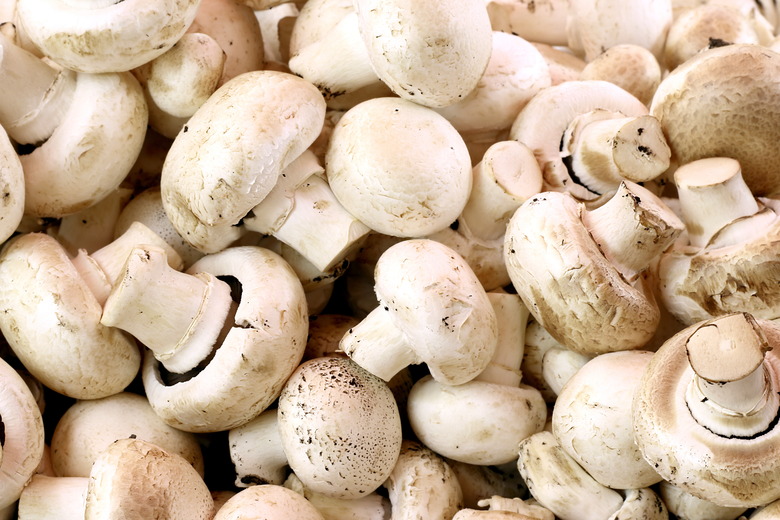The Life Cycle Of Agaricus Bisporus
If you or your parents have ever enjoyed some tasty mushroom slices on your pizza or enjoyed an appetizer of stuffed mushrooms while dining out at your local restaurant, you've encountered the incredibly popular mushroom species Agaricus bisporus. In fact, this mushroom species makes up about 90 percent of the mushrooms produced and consumed in the United States!
The Quintessential Mushroom
The Quintessential Mushroom
Scientists estimate that literally millions of different species of mushrooms exist on the planet. Despite this, Agaricus bisporus is so popular that most people simply call it a "mushroom." Agaricus bisporus is also referred to as the white button mushroom, table mushroom or pizza mushroom.
This mushroom species is even the same as the portobello mushroom, which is just Agaricus bisporus grown for a longer period so that its cap reaches a larger size. To many people, particularly in the United States, essentially no other type of mushroom exists.
The Mushroom Life Cycle
The Mushroom Life Cycle
Agaricus bisporus has a similar life cycle to most types of mushrooms. Like any fungus life cycle diagram, it is cyclical in nature, with adults producing spores that grow, develop and eventually reach an adult phase and produce spores of their own.
Inoculation
Inoculation
The first stage of the Agaricus bisporus life cycle is inoculation. Floating mushroom spores eventually settle onto a hospitable surface or substrate. If this location has the right conditions for the mushroom to survive, the spores move to the next stage – germination.
Spore Germination
Spore Germination
During the spore germination stage, individual spores begin to grow tiny filaments known as hyphae. Male and female hyphae in close proximity come together to produce fertile mycelium. This mycelium is similar in fashion to the roots of true plants.
Mycelial Expansion
Mycelial Expansion
This portion of the life cycle constitutes the mycelium growth stages, or the period where the mycelium of the fungus expands and develops. This growth occurs exponentially. The mycelium works to break down organic matter and absorb the nutrients released to fuel its continued growth. The mycelium also contains protective components to repel competitors and deter predators.
Hyphal Knot
Hyphal Knot
In this stage of the life cycle, the mycelium begins to grow upon itself and condense into a knot-like structure. This structure, known as a hyphal knot, gives rise to the eventual "body" of the mushroom. The mycelium produces many hyphal knots and primordia during this phase.
Primordia Formation
Primordia Formation
As the hyphal knot condenses and forms, it eventually becomes a primordia. This primordia is essentially a miniature version of the adult mushroom. A single mycelium produces as many as a thousand small primordia across its surface. Not all of these primordia form into the adult "fruiting body" of the mushroom.
Fruitbody Selection
Fruitbody Selection
Only the fastest-growing and most productive of the primordia will develop into fruiting bodies. Each individual fruitbody is what you think of when you imagine a "mushroom." However, these fruiting bodies are not separate organisms, but a single organism connected by its mycelium. These fruiting bodies continue to grow and develop into the adult form of the mushroom.
Mature Fruitbody
Mature Fruitbody
As the mushroom reaches maturity, it focuses its growth into the fruitbody, which it will eventually use to reproduce. The mushroom continues to grow and develop until it reaches full maturity and produces spores. The Agaricus bisporus mushroom that you eat in your meals is the fruiting body portion of the mushroom.
Spore Release
Spore Release
During this final stage in the life cycle, the mature fruitbody releases large volumes of microscopic spores into the air. The mushroom releases the spores from the gill structure on the underside of its cap. These spores eventually descend onto a surface and begin the life cycle again in the inoculation phase.
Cite This Article
MLA
Zinni, Yasmin. "The Life Cycle Of Agaricus Bisporus" sciencing.com, https://www.sciencing.com/the-life-cycle-of-agaricus-bisporus-13427019/. 20 October 2021.
APA
Zinni, Yasmin. (2021, October 20). The Life Cycle Of Agaricus Bisporus. sciencing.com. Retrieved from https://www.sciencing.com/the-life-cycle-of-agaricus-bisporus-13427019/
Chicago
Zinni, Yasmin. The Life Cycle Of Agaricus Bisporus last modified August 30, 2022. https://www.sciencing.com/the-life-cycle-of-agaricus-bisporus-13427019/
